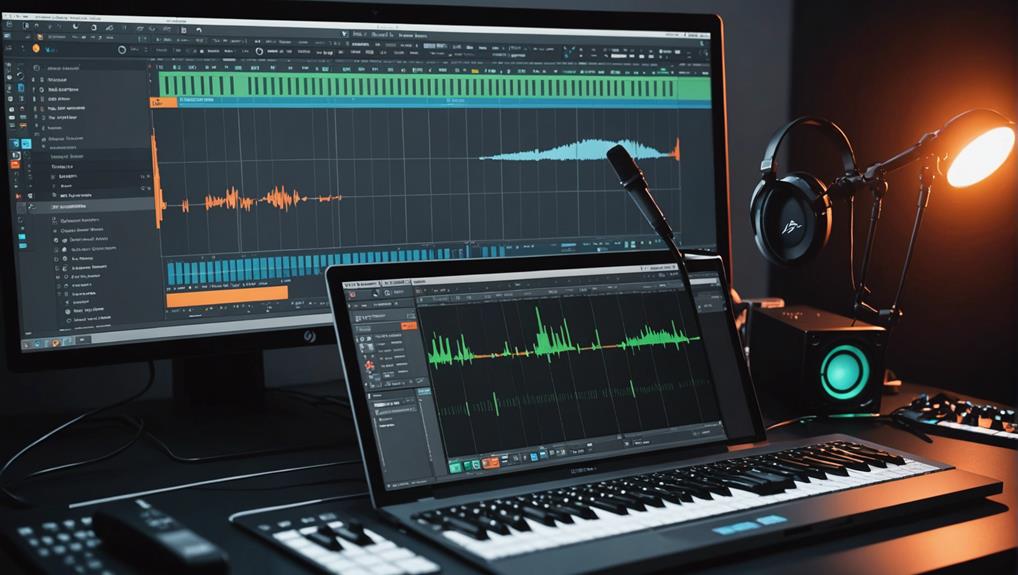Adding plugins to FL Studio is an efficient process. Start by downloading the plugin installer and running it, confirming compatibility with your version. Define the plugin installation folder, usually in C:Program FilesVSTPlugins. After installation, restart FL Studio and use the Plugin Manager to scan for new plugins. Organize frequently used plugins by adding them to Favorites and maintaining a clear structure in your Plugin Manager. Regularly check your plugin paths and troubleshoot any issues to guarantee smooth functioning. Mastering these steps can greatly enhance your workflow, leading to even greater insights into plugin management and optimization.
Key Takeaways
- Download the plugin installer from a trusted source and ensure compatibility with your FL Studio version.
- Install the plugin in the designated folder, typically C:Program FilesVSTPlugins, or a custom location.
- Restart FL Studio and use the Plugin Manager to rescan for newly installed plugins and check for updates.
- Organize plugin locations by navigating to Options > General Settings and adding necessary paths for VST2, VST3, and AU plugins.
- Verify installation by using the Plugin Manager to find new plugins and create custom folders for better organization.
Install the Plugin
To successfully install a plugin in FL Studio, begin by downloading the plugin installer from a trusted source, ensuring compatibility with your version of the software.
Once downloaded, run the installer and follow the prompts. You can either select the default installation location, typically C:Program FilesVSTPlugins on Windows, or choose a custom path that suits your preferences.
After installation, verify the plugin location to confirm that you have installed the plugin correctly. It’s essential to restart FL Studio after installation, as this allows the software to recognize and integrate the new VST plugins on Windows. Additionally, using essential plugins enhances your workflow and sound quality, making your music production experience more efficient and enjoyable.
Define Plugin Location
Defining the plugin location in FL Studio is essential for guaranteeing that the software can effectively access and utilize your installed VST and AU plugins.
For Windows users, the process is straightforward:
- Navigate to Options > General Settings.
- Open the Plugin Manager by clicking on Manage Plugins.
- Use the Add Path button to include the folder where your plugins are installed.
- Guarantee the correct paths for VST2, VST3, and AU plugins are set for seamless integration.
After adding plugin search paths, select Find Plugins to update the plugin database. Additionally, it’s important to ensure the plugin matches your Logic Pro X version for optimal compatibility.
Scan for New Plugins
Efficiently managing your plugin library in FL Studio begins with scanning for new plugins. To do this, navigate to the Options menu and select Manage Plugins to access the Plugin Manager. Click the “Find Plugins” button, which will initiate a scan of all directories specified in the plugin search paths for newly installed plugins. Newly detected plugins will appear under Installed > Effects or Installed > Generators in the Plugin Database for easy access. If some plugins do not show up, verify that their installation path is included in the Plugin Search Paths settings. Regular rescanning after installations or updates is essential for a streamlined workflow in FL Studio. Additionally, regularly rescanning the plugin list helps ensure that you have the latest versions of your plugins available for use.
| Action | Description |
|---|---|
| Navigate to Options | Open the Options menu and select Manage Plugins. |
| Click “Find Plugins” | Initiate the scan for new plugins. |
| Check Installed | View newly added plugins under Installed sections. |
| Verify Installation | Confirm plugin paths are correctly set. |
Add to Favorites
Organizing your plugin collection by adding frequently used plugins to your Favorites in FL Studio can greatly enhance your workflow.
By following a simple process to add plugins, you guarantee quicker access during music production sessions.
Regularly maintaining this Favorites list not only saves time but also boosts overall efficiency in your creative process. Additionally, utilizing native autotune plugins like Pitcher and NewTone can further streamline your vocal production workflow.
Quick Access Organization
To enhance your workflow in FL Studio, utilizing the “Add to Favorites” feature for plugins can greatly streamline your music production process.
By organizing your favorite plugins, you can guarantee quick access, fostering creativity and efficiency. Here are some key benefits of this feature:
- Easily retrieve frequently used plugins in FL Studio.
- Create folders within the Favorites section for better organization.
- Regularly update your Favorites list based on specific project needs.
- Enjoy faster navigation to your most-used plugins.
- Access your Favorites directly from the Browser on the left side.
Streamlined Workflow Enhancement
Many producers find that a well-curated Favorites list within FL Studio greatly improves their workflow. By right-clicking on any plugin in the Plugin Database and selecting “Add to Favourites,” you can create a quick-access list tailored to your most-used tools.
This organization reduces the time spent searching through extensive plugin lists, markedly enhancing overall workflow efficiency. Utilizing the Favorites feature streamlines project setups, allowing you to quickly locate essential plugins without traversing multiple categories.
Regularly updating your Favorites list guarantees it remains relevant to your current projects and production style. For those with large collections of plugins, this functionality offers personalized organization, catering to unique production needs and assuring a more efficient and creative process.
Manage Plugin Paths
Managing plugin paths in FL Studio is essential for organizing your audio production environment.
By defining the installation locations of your plugins and using the “Add Path” feature, you can make certain that FL Studio recognizes all installed plugins.
After updating these paths, remember to scan for plugins to keep your workflow efficient and streamlined. Regularly checking plugin compatibility ensures a seamless integration process and helps avoid potential issues during production.
Define Installation Locations
Defining installation locations for plugins in FL Studio is essential for guaranteeing that the software can effectively recognize and utilize all available tools.
Proper management of plugin paths enhances workflow and accessibility. Here are key considerations:
- Add the folder where your plugins are installed to the Plugin Manager.
- Guarantee the correct VST versions are targeted based on your FL Studio bit version.
- Regularly check and update your plugin paths for new installations.
- Use the “Find Installed Plugins” feature to scan and confirm recognition.
- Maintain a streamlined workflow by keeping your plugin paths organized.
Add and Scan Paths
To guarantee that FL Studio can effectively utilize all installed plugins, adding and scanning appropriate paths is an essential step in the setup process.
Begin by opening FL Studio and directing to Options > Manage Plugins to access the Plugin Manager. Use the “Add Path” button to include directories where your plugins are installed, making certain FL Studio can locate them efficiently.
After adding the necessary paths, click on the “Find Plugins” button to scan these directories for any newly installed plugins.
It is crucial to confirm that the paths correspond to the correct plugin formats, such as VST or AU, for seamless integration.
Regularly check and update these plugin paths to maintain an organized workflow and guarantee all plugins are accessible in your projects.
Troubleshoot Installation Issues
When encountering installation issues with plugins in FL Studio, it is essential to first verify that the plugins are installed in the correct directory specified in FL Studio’s settings. Improper installation paths can prevent recognition of the plugin.
To troubleshoot effectively, consider the following steps:
- Confirm the plugin format (VST, AU, etc.) and bit version (32-bit or 64-bit) are compatible with your FL Studio version.
- Use the “Find Installed Plugins” feature in the Plugin Manager to rescan for newly installed plugins.
- Check for updates to both FL Studio and the plugins for maximum functionality.
- Consult the plugin manufacturer’s documentation for tailored installation instructions.
- Restart FL Studio after making changes to confirm all updates are recognized. Additionally, ensure the plugin files are located in the appropriate plugin folder to facilitate smoother integration with FL Studio.
Organize Your Plugin Database
After resolving any installation issues, attention turns to the organization of your plugin database in FL Studio. Properly organizing installed plugins is essential for efficient access during music production.
Utilize the Plugin Manager to create custom folders that categorize plugins by type or purpose, enhancing retrieval. Regularly check and categorize your Effects and Generators to maintain a clear structure, minimizing clutter.
The “Add to Favourites” feature allows you to streamline your workflow by marking frequently used plugins. Additionally, periodically refresh the Browser by right-clicking on Packs and selecting “Refresh” to guarantee that all newly added plugins are accurately displayed in your plugin database. This organized approach will greatly improve your production efficiency, especially when using advanced mixing techniques that require quick access to your tools.
Frequently Asked Questions
How Do I Add Plugins to FL Studio?
To effectively add plugins to FL Studio, consider various plugin types and installation methods. Employ troubleshooting tips for compatibility issues, and utilize best practices for plugin organization to enhance your workflow and streamline access to your tools.
How Do I Add Plugins to Studio?
To add plugins to your studio, guarantee proper VST installation, manage your plugin paths, and regularly check for FL Studio updates. This enhances your sound design, music production, and mixing techniques for peak results.
How Do I Add Plugins?
To add plugins effectively, guarantee VST compatibility, utilize plugin management tips, explore the best free plugins, and consult an installation troubleshooting guide while optimizing plugin performance for a seamless audio effects overview in your projects.
How Do I Add Plugins to the Menu in FL Studio?
To enhance plugin management and menu customization in FL Studio settings, add your audio effects and virtual instruments through the Plugin Manager. Organize your plugins effectively for streamlined access and improved workflow efficiency within the software.
Conclusion
To conclude, integrating plugins into FL Studio enhances the creative process and expands the software’s functionality. By following the outlined steps—installing the plugin, defining its location, scanning for new additions, adding favorites, managing paths, troubleshooting issues, and organizing the plugin database—users can streamline their workflow and improve efficiency. A well-organized plugin setup contributes to a more productive environment, ultimately leading to higher-quality music production and a more satisfying user experience.



